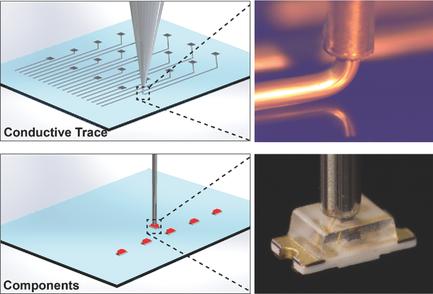当前位置:
X-MOL 学术
›
Adv. Mater.
›
论文详情
Our official English website, www.x-mol.net, welcomes your feedback! (Note: you will need to create a separate account there.)
Hybrid 3D Printing of Soft Electronics
Advanced Materials ( IF 29.4 ) Pub Date : 2017-09-06 , DOI: 10.1002/adma.201703817 Alexander D. Valentine 1 , Travis A. Busbee 1 , John William Boley 1 , Jordan R. Raney 1 , Alex Chortos 1 , Arda Kotikian 1 , John Daniel Berrigan 2 , Michael F. Durstock 2 , Jennifer A. Lewis 1
Advanced Materials ( IF 29.4 ) Pub Date : 2017-09-06 , DOI: 10.1002/adma.201703817 Alexander D. Valentine 1 , Travis A. Busbee 1 , John William Boley 1 , Jordan R. Raney 1 , Alex Chortos 1 , Arda Kotikian 1 , John Daniel Berrigan 2 , Michael F. Durstock 2 , Jennifer A. Lewis 1
Affiliation

|
Hybrid 3D printing is a new method for producing soft electronics that combines direct ink writing of conductive and dielectric elastomeric materials with automated pick‐and‐place of surface mount electronic components within an integrated additive manufacturing platform. Using this approach, insulating matrix and conductive electrode inks are directly printed in specific layouts. Passive and active electrical components are then integrated to produce the desired electronic circuitry by using an empty nozzle (in vacuum‐on mode) to pick up individual components, place them onto the substrate, and then deposit them (in vacuum‐off mode) in the desired location. The components are then interconnected via printed conductive traces to yield soft electronic devices that may find potential application in wearable electronics, soft robotics, and biomedical devices.
中文翻译:

软电子的混合3D打印
混合3D打印是一种生产软电子产品的新方法,该方法将导电和介电弹性材料的直接墨水书写与集成式增材制造平台中表面贴装电子组件的自动贴装相结合。使用这种方法,可以在特定布局中直接印刷绝缘基体墨水和导电电极墨水。然后,通过使用空喷嘴(在真空开启模式下)拾取单个组件,将它们放置在基板上,然后将其沉积(在真空关闭模式下),将无源和有源电子组件集成在一起以产生所需的电子电路。所需的位置。然后,这些组件通过印刷的导电走线相互连接,以生产软电子设备,这些软电子设备可能会在可穿戴电子设备,软机器人,
更新日期:2017-09-06
中文翻译:

软电子的混合3D打印
混合3D打印是一种生产软电子产品的新方法,该方法将导电和介电弹性材料的直接墨水书写与集成式增材制造平台中表面贴装电子组件的自动贴装相结合。使用这种方法,可以在特定布局中直接印刷绝缘基体墨水和导电电极墨水。然后,通过使用空喷嘴(在真空开启模式下)拾取单个组件,将它们放置在基板上,然后将其沉积(在真空关闭模式下),将无源和有源电子组件集成在一起以产生所需的电子电路。所需的位置。然后,这些组件通过印刷的导电走线相互连接,以生产软电子设备,这些软电子设备可能会在可穿戴电子设备,软机器人,



























 京公网安备 11010802027423号
京公网安备 11010802027423号